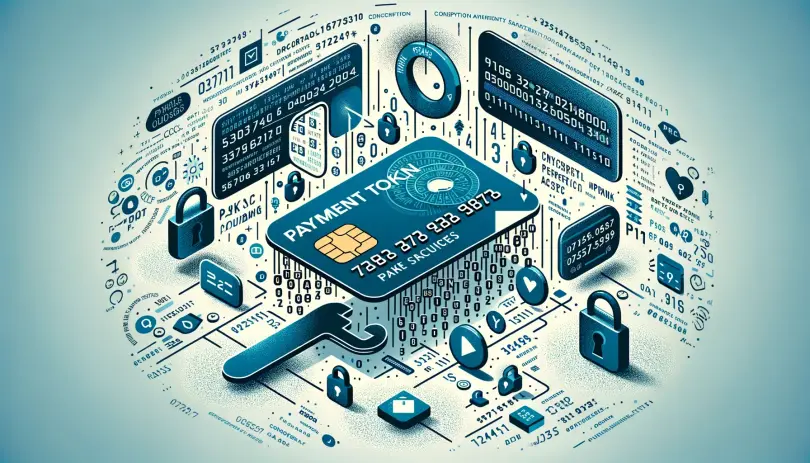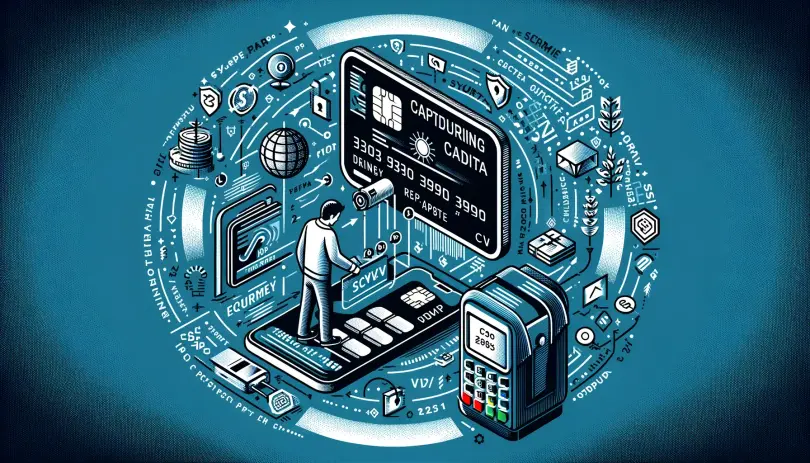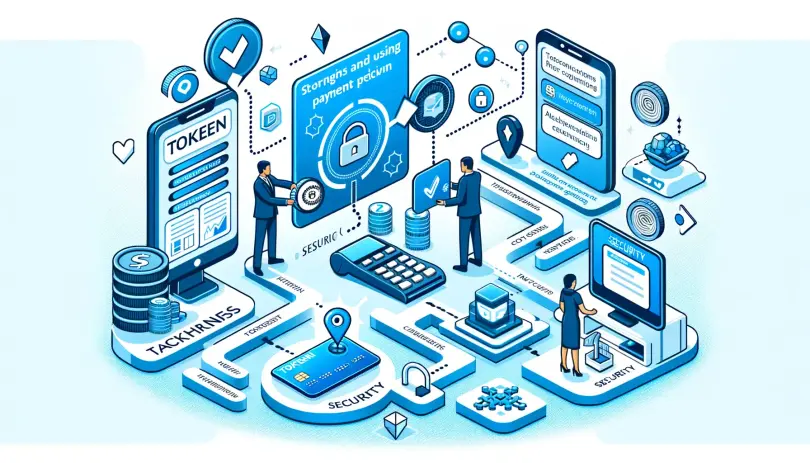Safe and Seamless: The Magic of Payment Tokenization
Contents

In the world of online transactions, fraud prevention and protection against cyber threats are key priorities for any business that deals with digital payments. This is where payment tokenization swoops in as a game-changer.
What is tokenization in payments, and how is it relevant to the discussion? In brief, it’s the process of adding an extra layer of protection to transactions by encrypting vulnerable financial data and personal details and converting them into lines of symbols, so-called tokens.
With the rise of ecommerce and the consistent expansion of online marketplaces, the volume of sensitive data transmissions has soared, increasingly exposing individuals and companies to cyberattacks. Hence, tokenization payment methods should not be underestimated. Significantly mitigating the risks associated with data breaches and scams, this approach greatly contributes to ensuring more secure transactions.
So, how does tokenization work in payments, and what advantages does it bring to businesses? Let’s find out.
The Role of Payment Tokenization
What is a payment token? Replacing confidential financial info like credit card numbers, bank account details, or personal identification numbers (PINs), tokens are randomized combos of figures and letters generated by cryptographic algorithms when a transaction is initiated. They have no relation to the original data they represent and bear no intrinsic value. As such, they make it nearly impossible for hackers to access or decipher payment data without an associated decryption key.

Tokenization in payments (be it credit card tokenization or mobile payment tokenization) reduces the risk of data breaches during storage or transmission, as tokens have no value if intercepted. At the same time, tokens are just as reversible as any other encryption method. Authorized entities with access to the payment token system can reverse the process by matching tokens with their corresponding data in a secure environment.
Tokenization plays a crucial role in both regular and mobile banking security by:
- Ensuring confidentiality: With valuable payment data and personal details encrypted into tokens, the risk of unauthorized data access and theft is greatly reduced, safeguarding both businesses and their customers;
- Reducing compliance complexity: By minimizing the scope of sensitive data and restricting access to cardholders’ personal information, payment tokenization facilitates PCI DSS compliance for merchants;
- Maintaining transactional efficiency: Despite the substitution, tokenization allows for a smooth transaction process. This way, merchants and service providers can process payments and access necessary data swiftly and without compromising security.
How Payment Gateway Tokenization Works?
To answer the question, “What is payment tokenization?” we must keep in mind its primary aim: to keep sensitive financial information encrypted while ensuring seamless digital transactions. The whole process of employing tokens can be understood as balancing these two goals, adding an additional layer of protection without compromising speed or convenience. Payment gateway tokenization is a multistep operation that safeguards all types of online payments, mobile payments, and contactless payments you make offline.
Capturing Data
When a customer initiates a transaction using online payment methods or paying in person via POS, the system captures the relevant information for processing. Typically, the primary account number (PAN), expiration date, and security code (CVV/CVC) are encrypted immediately at the point of capture. The coded data is then transmitted securely to the payment processor or gateway.

Requesting Tokenization
Upon receiving the encrypted data, the payment processor interacts with a tokenization system or Token Service Provider (TSP). It’s a specialized entity or service managing the payment tokenization process. TSPs operate cyberattack-proof systems and employ robust security measures to handle sensitive data, convert it into tokens, and maintain shielded bonds between them.
Merchants can become their own TSPs to reduce maintenance costs and further enhance their security level. This way, they can avoid paying service fees and acquire full control of their original payment credentials.
The request to TSP includes the specific details that need protection. It’s normally sent via secure channels to ensure the ultimate confidentiality of the info being shared.
Creating Tokens
Using the selected tokenization algorithm, the TSP issues a substitute value or a token for the data that requires secrecy. Those algorithms are cryptographic techniques, ensuring that the tokenized output is unique and bears no direct relation to the original data. Examples include format-preserving encryption, hashing, or other security tactics tailored for backing tokenized transactions.
Notably, the process of payment token creation might involve rules to ensure uniqueness and security, and it often follows specific formatting guidelines based on the tokenization method used.
Storing and Using Tokens
The tokenized payment information is sent by the payment gateway to the processor or acquiring entity for authorization and verification. The processor then checks the token validity and approves or rejects the transaction.
While the transaction is occurring, tokens are stored in the merchant's system, payment gateway, or even the device used for the transaction (in cases of mobile wallets) instead of the actual card data. This significantly reduces the risk of breaches and enhances fraud resistance.

TSPs usually maintain secure informational vaults to manage digital tokens securely and enable authorized entities to use them for permitted operations, such as payment processing or data analysis.
Reusing Tokens
After the transaction is completed, the tokenized payment credentials can be safely stored in the system for further use. Thus, similar tokens can be used for recurring payments, saving the need to capture and potentially expose sensitive data again. It prevents data leakage and further elevates overall security for regular offline, online, and mobile payments.
Key Components of Token Payment System
A token payment system relies on several core components that work as a “team” to facilitate secure transactions.
Tokens
A token is a primary component of the whole tokenization system. It’s a unique identifier of financial credentials that acts as a stand-in during digital payments processing, protecting the actual sensitive information from exposure.
To add an extra layer of protection, tokenized payment credentials can be limited in use. This means they are specific to a particular transaction, merchant, or purpose.
Token Vault
Token vault is a secure repository that maintains the mapping between tokens and their corresponding original data. This association is stored in a highly protected environment, ensuring that confidential info remains inaccessible to outsiders while allowing authorized parties to retrieve the initial data when needed.
Tokenization Servers or Services
Such systems monitor and oversee the entire process of issuing tokens, managing the token vault, and maintaining tokenized transactions. They handle the tokenization lifecycle to guarantee that sensitive data is substituted by digital surrogates and doesn’t leak out from the repository.
Encryption and Data Transmission Protocols
These protocols, such as Transport Layer Security (TLS) or Secure Sockets Layer (SSL), encipher the data during transmission between various entities involved in the payment process. Such coding ensures that even if compromised, the data remains unreadable.

Boosting Business With Tokenization
Now that you have the answer to “What are tokenized transactions?” it’s important to discuss how businesses can benefit from them. Tokenization is a powerful tool for companies striving to bolster their payment systems and overall operations. Implementing payment tokenization brings several advantages that can tangibly boost a business's performance and reputation.
Improved Security
Tokens wrap your customers' financial details in an invisible shield, thwarting any attempts to steal valuable data. Unlike traditional methods that typically involve information floating around in systems and thus being prone to breaches, tokens are virtually useless even if intercepted. Such an approach reduces data theft, safeguarding both the business and its clients from potential financial losses.
Fraud Prevention
Along with two-factor authentication (2FA), payment tokenization services substantially decrease the risk of fraudulent operations. Completely inaccessible without decryption keys, tokens can’t be used for unauthorized transactions. This significantly lowers the chances of successful cyberattacks, protecting a business against financial liabilities and reputational damage.
Increased Customer Trust
When conducting digital payments, customers expect the ultimate security and privacy. By implementing tokenization in payments, merchants demonstrate a commitment to protecting sensitive customer data. This, in turn, fosters trust and confidence among the clients. They are encouraged to engage with the business more frequently and confidently, leading to increased loyalty and repeated purchases.
Operational Efficiency
Tokenization helps streamline payment processes. It reduces the burden of managing and securing vast amounts of sensitive info, allowing businesses to allocate resources more efficiently. Furthermore, it can simplify payment reconciliation and reporting.
Adaptability and Scalability
Tokenization solutions are adaptable to various payment methods and can scale with business growth. Whether it's online transactions, mobile payments, or other emerging payment technologies, tokenization provides a versatile and scalable approach that accommodates evolving business needs.
Ensuring Compliance for Business Security
In digital transactions, tokenization is a critical and widely used security measure. As such, the implementation of payment tokenization is strictly governed by regulatory standards to ensure payment data integrity, secrecy, and security.
- Payment Card Industry Data Security Standard (PCI DSS) mandates security controls for businesses handling payment card info. PCI DSS compliance is essential for entities involved in tokenization processes to safeguard customer data;
- General Data Protection Regulation (GDPR) imposes guidelines on the processing and protection of personal data for businesses operating in the European Union. Compliance involves obtaining explicit consent and ensuring the lawful processing of such data;
- Local Regulatory Authorities have their own regulations pertaining to data protection and financial transactions in specific countries. For instance, in the United States, the GLBA and HIPAA acts could also apply depending on the nature of the business.

To stay on top of the regulations when applying tokenized transactions, businesses should:
- Clearly understand regulatory requirements;
- Adopt the corresponding security standards and measures;
- Obtain professional advice on regulatory compliance;
- Conduct regular audits and expert assessments to stay compliant;
- Maintain comprehensive documentation and accurate records to demonstrate compliance if necessary.
Final Thought
For companies operating in the digital space, payment tokenization is not an option, but a necessity. Not only does it fortify transactional security, but also fosters compliance, and trust, and grants the business a competitive edge. It’s all about protecting your customers and securing the foundation for sustainable business growth in a rapidly evolving digital economy.
FAQ
How does payment tokenization differ from traditional payment methods?
Simply put, tokenized transactions bring payment security to a new quality level by minimizing the use and exposure of sensitive data. This reduces the risk of data breaches and increases overall transactional safety compared to traditional payment methods.
What security measures are inherent in payment tokenization?
Tokenization of payments enhances security using data encryption and coding. Besides, token payment systems often integrate authentication and authorization protocols, ensuring that only authorized users or entities can access and use the tokens.
Can you provide examples of businesses that have successfully implemented payment tokenization?
Tech giants, payment processors, and financial institutions widely implement tokenization to protect sensitive payment credentials and card data — Apple Pay, Google Pay, Stripe, and Braintree, to name a few.




